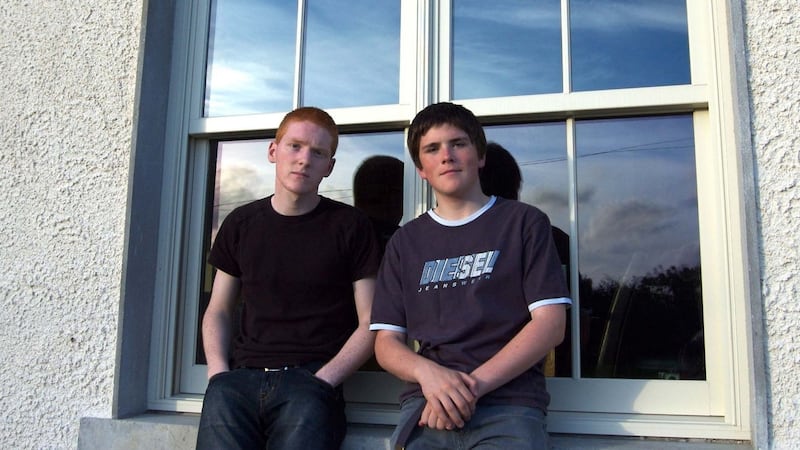John Collison may have been a millionaire since the age of 18 and a billionaire since November 2016, when he and his brother Patrick's company Stripe was first valued at $1.1 billion, but you wouldn't know.
The 30-year-old arrives by bike. There are no PR minders, just him, his cup of coffee and his bicycle helmet resting on the table.
We're sitting outside for social distancing purposes and there's a nip in the air but Collison is warm and relaxed. He's been living in Silicon Valley for more than 10 years now, but has been staying in Dublin since the end of October and is here until just before Christmas. Born in Limerick and raised in Dromineer, Co Tipperary, the Irishman is clearly relishing the opportunity to spend a bit more time than usual back home.


“I usually just come back for a few days at a time, but had been thinking recently it would be good to spend longer here. It’s been great in terms of catching up with friends and also for talking to customers who are in the same time zone. It makes a big difference,” he says.
Collison arrived in the city just in time for the second lockdown and so hasn’t been able to enjoy the city as freely as he might do in normal circumstances. But he says he has been meeting work colleagues for socially distanced walks and has been getting out running fairly regularly.
“I’d say that like most people much of my time right now is being spent compiling lists of things I want to do once lockdown is finally over,” he says.
Friendly but guarded, Collison’s happy to talk about Stripe’s success, on the possibility of an IPO, what role the company’s Dublin hub plays for the company, and how he and his brother feel they are still only just getting started after being in business for a decade.
The online payments company was valued at $36 billion following a fundraise earlier this year, although there is speculation it is now worth considerably more given the zest with which companies have embraced e-commerce during the Covid crisis.
Stripe is rarely out of the news but in recent weeks it has been in the spotlight even more than usual, partly because of reports the company is in talks to raise further funds at a $100 billion valuation, something it has downplayed. In addition, it recently expanded its Stripe Capital lending business to online platforms in the US, and made its biggest acquisition to date with a move to buy Nigerian payments start-up Paystack in October – a deal valued at more than $200 million.
Stripe also made a splash earlier this month when it announced it is teaming up with some of the world's largest banks – including Citigroup, Goldman Sachs and Barclays – to offer checking accounts to businesses that sell their wares on e-commerce platforms such as Shopify.
Stripe’s vision
Collison laughs at the reaction to that news and at how onlookers seem to be continually surprised at how the company is evolving given that he and his brother believe they’ve been upfront with their plans.
“Stripe’s vision is to make it easy for anyone anywhere to participate in the internet economy. We thought we’d been making it clear we’d do something along these lines as part of our strategy, which is essentially to build a global payments and treasury network that works everywhere,” he says.
It’s fair to say that 2020 has been an odd year for everyone but for the Collisons, business has been booming at an even faster rate than normal.
“Every year I think ‘ah next year will be calmer’, but that is rarely the case and it certainly hasn’t for 2020,” says Collison.
Since the lockdown started, more than 300,000 new businesses have got started on Stripe’s platform. The brothers have long argued that with only a fraction of commerce currently taking place online, there are plenty of opportunities for the company, both in relatively mature markets and in developing ones. He points out that even in Britain, considered a mature e-commerce market, the Covid crisis led to an almost doubling of activity to 33 per cent.
“There is a misconception that somehow the issue of accepting payments online has been resolved, but the amount of commerce done via the internet is still low, with cross-border transactions in particular almost minimal,” says Collison.
“If you are an Irish business trading online, for example, it should be really easy for you to address a global market over the longer term, but you should be able to address an EU one immediately. However, because of the complexity of doing so, it often isn’t worth the hassle for organisations,” he says.
He says things are changing, albeit slowly, so he and his brother feel there is plenty of work still to do.
“Me and Patrick aren’t going anywhere because as we’ve talked about many times, we are very early on in the development of this problem. We think it is much harder to do business cross-border than it should be and we’re just settling down for another long period of working on it,” he says.
Given the huge opportunities, investors are more than keen to back Stripe, making it among the most valuable private companies in the world. Some critics have expressed astonishment that the company hasn’t gone public, not least because in Silicon Valley circles getting listed on the stock market is often seen as the holy grail.
Turnover
Stripe doesn't reveal revenue figures although accounts filed by the company's Dublin-headquartered subsidiary, which has responsibility for Europe, Middle East and Africa (EMEA), show turnover jumped by nearly 80 per cent to $528.7 million in 2018.
“Our business is not highly capital consumptive and we’re structured in a way that we can continually self-fund and so IPO considerations are secondary to us. If you sit in on a management meeting at Stripe, then we’re not talking about IPOs, but about customer issues and our product roadmap,” says Collison.
He seems bemused at the idea that he and his brother are visionaries for realising early on that online payments was a pain point for many businesses.
“Anyone could have come up with the idea for Stripe because you only had to talk to people who were trying to build internet businesses back then and they’d have happily talked your ear off about how frustrating it was dealing with payments,” he says.
“In fact, when we were first doing fundraising we would tell venture capitalists to talk with their portfolio companies to see how much of a problem it was for them. I’m not sure if those early investments in Stripe were really about us, or if it was more a case of VCs seeing there was a huge opportunity,” Collison adds.
Stripe’s technology handles hundreds of billions of dollars in transactions each year for its clients. Its early success was largely due to it working to simplify the payments process so software developers only needed to add in a couple of lines of code in order to accept online payments on websites. Its range of products has greatly expanded over the years, but the ease of use for which the company first became known is still central to its success.
He insists the key thing Stripe had up its sleeves when it came to convincing early investors to take a punt, was that they had a solution to the online payments problem they were able to identify.
“The only advantage we had was we had a product that existed. Code wins arguments. It meant that people didn’t even have to believe in us. They could just look at the data and see we were on to something,” he says.
The company's earliest supporters may have been largely tech start-ups but these days it boasts an impressive client list that also includes many of the biggest companies on the planet. This year alone Zoom, Just Eat, Mattel, and NBC have joined a roster of clients that also includes Amazon, Uber, Booking. com, Deliveroo and Google.
The Collison brothers were tipped for success early on with the family becoming well-known after Patrick won the Young Scientist competition in 2005 at the age of 16. The hype around them extended considerably after the brothers sold their first business Auctomatic for $5 million three years later. And then they dreamed up Stripe.
Both brothers often seem as though they would much rather be getting on with the work rather than having to patiently explain to the world what it is they are doing. But there is no escaping the limelight when Forbes has named you among the world’s youngest billionaires with the Collisons’ net worth estimated at $3.2 billion each.
“What Patrick and I have had, which is fortunate in many ways, is that we were like the boiled frogs who didn’t realise the heat was being gradually turned up on them. It’s the same in terms of how much responsibility we have now. We started as a two-person company with training wheels on, and over time have become an employer of 3,000 people. We were gradually eased into it all,” he says.
Silicon Valley
Escaping Ireland may also have been no bad thing as they didn't face as much pressure to succeed as they might have done here.
“If you’re a fast-growing start-up in Silicon Valley that is usually something pretty unremarkable,” he says.
Collison says that both the Valley and Dublin have changed significantly in recent years and that there isn’t necessarily such pressure to go to the US to succeed now.
"It is entirely plausible that you could set up Stripe in Dublin, Oregon or wherever, now" he says. "Everything has changed, and particularly so in light of the Covid crisis."
Stripe employs about 300 people in Dublin where one of its key engineering hubs is located. Collison says headcount will continue to grow locally although he’s not putting numbers on it.
Being in this part of the world for the last month or so has allowed Collison to chat more freely with customers, something he says is often something tech companies forget is necessary.
“A problem with making digital products is that the people who make them can become too distanced from their end users. My parents ran a hotel and so didn’t need to do complex user surveys to find out if customers were satisfied. They’d be told quickly if they weren’t. We try to keep close to our users and fortunately they aren’t afraid to tell us what’s not working as well as what is,” he says.
The plan for the next few years is “to continually make it easier for businesses to sell around the world.”
“This sounds deceptively simple but is actually extraordinarily complex when it comes to it,” Collison says.
Expansion is the name of the game with Stripe planning to launch in more markets globally with additional software products also coming down the line.
“It is a fabulous job I have. One that is not without its stresses but one where I constantly hear from customers who tell me their business would not be where it is today without Stripe. That is very satisfying,” he says.
Coffee drunk, conversation ended, Collison puts on his bicycle helmet and heads off down the road again.











